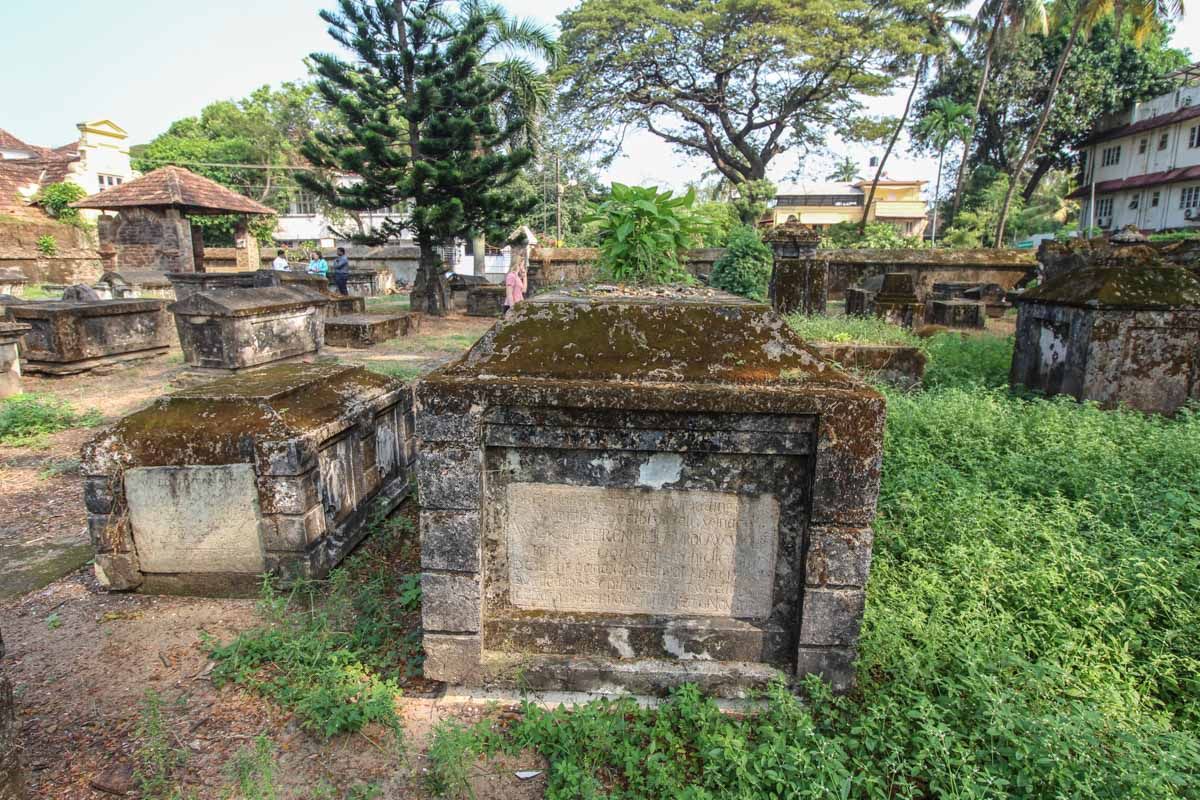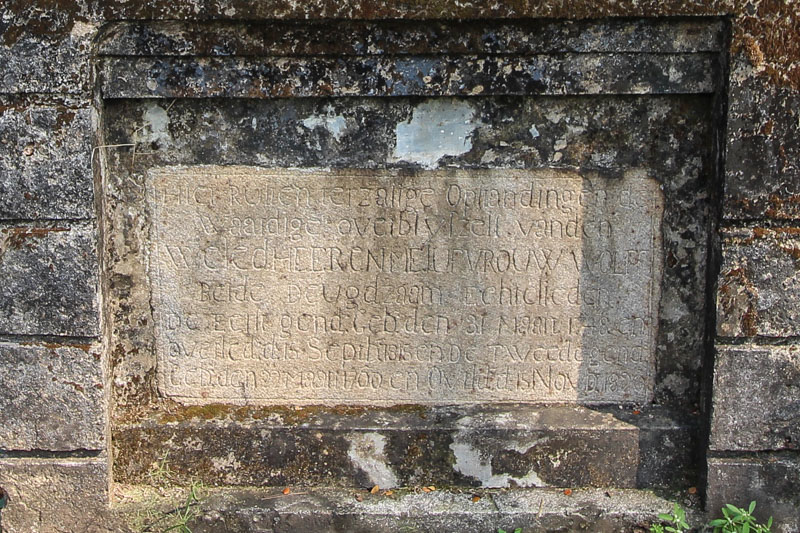
Fort Kochi - Johannes Wolff (1748-1815) en Catharina Sara Smit (1760-1820)
The funerary monument of the Wolff family does not provide many clues about who is buried here. No first names and even the surname of the woman is not known with certainty, nor the place where they were born. Despite the fact that they are buried in the Dutch cemetery, the name could just as well indicate an English, Belgian or German origin.
‘Hier ruhen ter zaligen opstandingen de / waardige overblyfzels van den / weled Heer en mejufvrouw Wolff / beide deugdzaam echtelieden / de eerste gend. geb. den 31 Maart 1748 en / overled: d: 18 Septb. 1815 / den tweede gend. Geb. den 22 maart 1760 en Overld: d: 15 Nov. D. 1820.’[i] In translation: ‘Here rests awaiting their resurrection, the dignified remains of the well-born sir en miss Wolff, both honest spouses the first named born on 31 March 1748 and died on 18 September 1815. The second named born on 22 March 1760 and died 15 November 1820.’ The tomb itself is in the style which was common during the British era. The deceased were buried in a grave and a large tomb was raised above it.
Is there a couple with the surname Wolff who had a son on 31 March 1748 in Kochi? That cannot be verified, because there is no baptism book of those years. Several men with the surname (de) Wolf(f) live in Kochi in the period in which this 'Sir Wolff' who is buried here was born. To name a few examples: Jacob Wolf, sergeant from Mannheim (Germany), arrived in 1732. A Carolus Wolf from Alberstad (?) as a corporal in 1739, Justus Wolf from Hannover (Germany) had arrived as a sergeant in 1730 and in 1748 a Barend Wolf lived in Kochi. A marriage record of Kochi between 1740 and 1750 does exist, but in that period no man married with the surname Wolff.
Only Jacob Wolf is known to have lived with a mestizo woman in Cochin in 1746.[ii] They have no children and no slaves. Because there is no further information, it is not possible to say whether it concerns an older couple or a young couple. A baptismal book is available from 1751. In December 1751 a Nicolaas Frederik Wolf was baptized. He is the son of one Wolf who is Lutheran and a woman whose middle name is Magdalena. The paper with the rest of the information is too damaged to be useful. Helena was baptized on March 18, 1753 as daughter of someone called Jacob Wolff, Lutheran, and Dirkje Jansz Claesz. Baptism witnesses are Hans Casper van Thiel and Aletta van den Berg. Jacob was baptized on 29 October 1754 as the son of Jacob Wolf, lieutenant and Detje Magdalena (crossed out Jansz) Claasz. Witnesses were Johan Russell and Helena Susanna Bos. In 1755 a Jacob Wolff is a baptismal witness together with Catharina Andreasz. He is not mentioned again after this. Theoretically, this could be one and the same Jacob and he could also be the father of the above-mentioned noble Mr. Wolff from 1748. But what was the name of Jacob's wife, and more importantly, is there any evidence that the late Mr. Wolff was their child?
Perhaps he was not born in Kochi though? The only man with the surname Wolff who still lives in Kochi after 1800 is a certain Johannes Wolff, an accountant born in Kochi. Together with a Sara Catharina Smit, he appears in the baptismal records from 20 October 1780 as a witness. The last time they are mentioned in that capacity is on 18 December 1803. After this, the baptism book stops. Yet it is known that they are both still alive in September 1807 when Adriaan Poolvliet's widow dies. Then Catharina Sara Smith, as Johannes Wolff's wife, received a ring with diamonds from the estate. Because Kochi had already been taken by the English 12 years earlier, there is little Dutch administration left to help further in this quest.
Reverse the scavenger hunt
If a quest from baby to old man doesn't work, then the search has to take place the other way around from old man to baby. Looking for information about Johannes it turned out that he appears very often in the archives. He is frequently mentioned as a witness in the drafting of wills. So he must have been good at keeping a secret. He is also regularly appointed as executor of the will. So he is trusted and many parents entrust him with custody of their children, even though he probably never had children himself. Fortunately, the VOC kept track of promotions very well. As a result, the career of Johannes Wolff can be traced back.
Johannes was employed by the VOC at the office in Kochi as a bookkeeper, but his last mentioned position was in 1788 as a bookkeeper on Porka (Purakkad). In 1790 he must have returned to Cochin, because the VOC had decided to close all establishments on the coast of Malabar except Cochin and Quilon due to declining income. Before 1788 Johannes was a bookkeeper in Kochi and he had been since 1775. Before that he was an absolute assistant from 1769 for 24 guilders a month. That same year a job became available and he became a young assistant with a salary of 16 guilders a month. He stayed that way for several years. At the appointment it is noted that he had already been working as a soldier for 9 years, but most of those years he served in the writing comptoire. He had enlisted as a soldier in 1756. There is serious doubt here. According to his tomb, he was born in 1748. A child of 8 years in the service of the VOC as a soldier? That's unlikely.
 Detail of the tombstone of the Wolff family (photo René ten Dam, 2020)
Detail of the tombstone of the Wolff family (photo René ten Dam, 2020)
Catharina Sara Smith
Then first look for Miss Wolff a.k.a. Catharina Sara Smith. She was baptized on 13 April 1760 in Kochi as daughter of Jan Smit and Sara Bos. Baptism witnesses were Jacob Harsing and Ajella Harmsz. Jan and Sara were married 29 July 1759[iii] and that immediately provides more information. Jan came to the East Indies in 1751 as a schieman and works as a boatswain on the chaloup[iv] Johanna Catharina.[v] Sara is the widow of dispender Jan Herman Clausing.[vi] They act as baptismal witnesses a few times, such as in July 1765 and May 1766, but appear to have had no further children. They appear to be still alive in 1777. They have 1 native woman, 4 enslaved men and 3 enslaved women and no children living at home.[vii] Jan Smit's muster roll mentions his death on 29 August 1788, leaving behind a widow and a daughter. With this information a will could be found. It was drawn up shortly after their marriage on September 29, 1759. They named each other sole heirs. If Jan dies earlier, Sara has to transfer 100 heavy Dutch guilders to his mother Catharina Smit living in Bolsvliet.[viii] Sara appointed her parents to inherit. There appears to be another surprise in the will when they promise each other that they will always take care of Jacob Ruis, the son of sergeant Michiel Ruis who they have adopted as their child. Catharina Sara did not grow up as the only child.[ix] Since she no longer lived with her parents according to the household register of 1777, you might expect, her being only 17 years old, she was married to Johannes Wolff who is at least 13 years older. In the same household register is a Johannes Wolff, born in Kochi, accountant at the secretary's office, 1 white man, 1 white woman, 4 enslaved men, 2 enslaved women and 2 girls.[x] Johannes is indeed a married man. For me this puzzle pieces fits, but what about the parents of Johannes?
The only couple that qualifies for this is Jacob Wolff, mentioned in 1746. He is a sergeant, a European man with a mestizo wife. But did they also demonstrably have a child named Johannes and are they identical to the couple Jacob Wolff and Dirkje Magdalena Claesz?.[xi] According to his muster roll, Jacob died on September 20, 1757.[xii] While lying ill in bed, Jacob and his wife Dirkje Magdalena Jansz. made up a will. Their heirs are their five sons named in order of birth: Jo(h)annes, Nicolaas, Jacob, Dirk and Hendrik.[xiii]
Despite the fact that the age of 8 years doesn't seem to fit with Johannes's entry into service, it seems that our sir Wolff has been identified with this one.
Johannes would once again stand up for himself in his capacity as guardian and that caused quite a riot in Kochi.
Notes
[i] Ed.: The transcription is not always displayed correctly and often appears to have been retranslated. The word 'ruhen' is often transliterated as 'rusten'. This seems to indicate a German-speaking origin.
[ii] In India mestiços are persons born of a European, often Spanish or Portuguese, father and an Indian mother or vice versa. Sometimes they are also known as ‘mestiças’ In a broader sense, anyone of mixed ethnic origin is sometimes referred to as mestiços. In English they are called mestees.
[iii] NA 1.11.06.11.506c scan 0176
[iv] Ship type
[v] NA 1.04.0213054 scans 080-081 Jan Smit van Stalden came with the Nieuwe Vijvervreugd from the Zeeland Chamber, sailed on the Anna, the Pijlstaart, Mariënbos and Crabbendijke until March 1757 and then arrived in Cochin.
[vi] NA 1.04.02.6865 scan 0915. Jan Herman Clausing, accountant and dispenser Cochin, makes a will with his wife Sara Bos van Batavia on 8 October 1752. He is ill and weak. Earlier will Jan 1751 on the longest-living. If he dies without children, she must pay a sum of 300 realen a 48 st. transfer to his mother Johanna Elisabeth Rijmers wed. Clausing lives up to Saltofle in County Lippe, but when she dies it must go to his brothers and sisters Juliana, Florentina, Jan Adolph and Johanna Clausing. The first two live in Amsterdam, the others with their mother. In her case, her two parents inherit. In 1742 he left for the Amsterdam chamber as a soldier for 9.00 guilders.
[vii] NA 1.04.02.12505
[viii] Bolsvliet is a disappeared village in the vicinity of Heinkenszand in Zeeland (the Netherlands)
[ix] NA 1.11.06.11.1279 scan 0046
[x] NA 1.04.02.12505 scan 0087
[xi] Claes is a derivative of the first name Nicolaas
[xii] NA 1.04.02.14404 scan 0243 He came to the East Indies in 1732 with the Cornelia as a soldier for fl 9.00 a month. He had been on Cochin since 1740.
[xiii] Helena died in 1754, Jacob would die in his own home on 16 September 1778. He was a surgeon, married but childless. He was buried in the cemetery. Dirk (also deceased childless) and Hendrik were probably born in 1755 and 1756, but the baptismal record of 1755 has only been preserved in part and those of 1756 and 1757 are missing.
- Last updated on .


